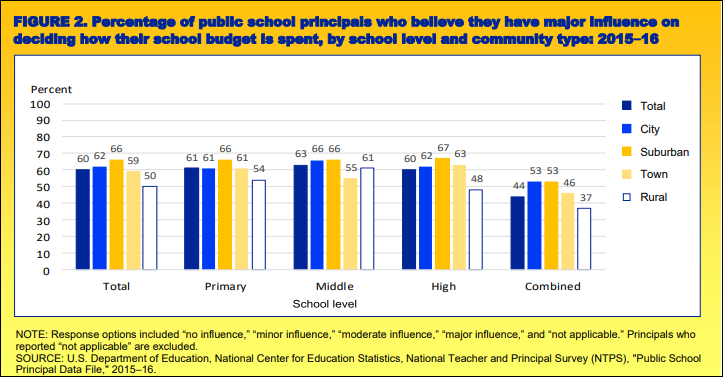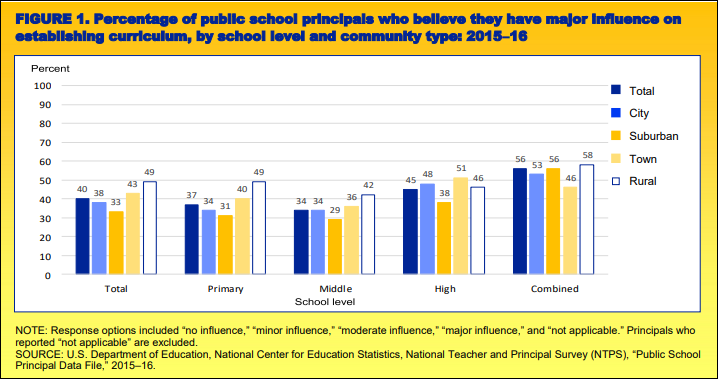Principals Report More Influence Over School Budgets Than Curriculum Choice in National Survey
Sixty percent of public school principals say they have a major influence over their school budgets, while only 40 percent said they have that same amount of influence on establishing curriculum, according to a national study released this week by the federal government.
Principals in suburban schools were the most likely to say that they have a major influence on school budgets (66 percent), but they were least likely to report that level of influence on curriculum choices (33 percent.)
The study—called “Data Point: Public School Principals’ Perceptions of Influence by School Level and Community Type”—is based on responses to a questionnaire from the U.S. Department of Education’s National Center for Education Statistics 2015-16 National Teacher and Principal Survey. This nationally representative sample survey polled principals in public K-12 schools in the 50 states and the District of Columbia.
The public school principals were asked, “How much ACTUAL influence do you think you have as a principal on decisions concerning how your school budget will be spent?” [The emphasis was part of the question.]
For the principals who found this question relevant, suburban high school principals reported the highest percentage of influence—67 percent—but that was close to the 66 percent of city and suburban middle school principals and suburban primary school principals who said they have a major influence. Rural principals had the fewest respondents in that “major influence” category, with only 50 percent responding at that level—a pattern that was especially notable for rural high school principals.
See the other findings in the chart below. A “combined school” is defined as having at least one grade lower than 7 and at least one grade higher than 8, or with all students in ungraded classrooms. Primary schools have at least one grade lower than 5 and no grade higher than 8, while middle schools are defined as having no grade lower than 5 and no grade higher than 9. High schools have no grade lower than 7 and at least one grade higher than 8.

Influence on Establishing Curriculum
Fewer principals, across the board, report having a major influence on curriculum selection than they do on budgets.
Asked “How much ACTUAL influence do you think you have as a principal on decisions concerning established curriculum at this school?,” principals from rural schools had the highest (49 percent), and from towns the next highest (43 percent).
Suburban middle school principals were least likely to say they have a major influence in this area, with 29 percent in that category, and 31 percent of suburban primary principals at that level of influence.
Other than in combined schools, high school principals from towns are most likely to report having a major influence on establishing curriculum, the study found, with 51 percent reporting that level of influence.
See how principals leading different levels of schools and from various types of communities responded below:

From Education Week‘s 2018 Technology Counts research, we found another area where principals are feeling pressure: the proliferation of technology in their schools.
To better understand where the ed-tech pressure points are for principals, the Education Week Research Center conducted a nationally representative survey of 500 principals, assistant principals, and other school leaders. Technology Counts 2018 incorporates that data in the report, while taking a hard look at what principals are thinking and doing about some of the most vexing technology issues in their schools.
Our findings show that principals are struggling with questions like, “Is personalized learning worth embracing?” and “Are students spending too much time in front of computer screens?”
We’ve captured what principals really think about tech on this page with interactive charts summarizing our findings.
Follow EdWeek Market Brief on Twitter @EdMarketBrief or connect with us on LinkedIn.
See also:
- What School Principals Really Want From Education Companies
- What Principals Really Think About Tech
- A Big Push in States for PD, Leadership Skills for Superintendents, Principals
- Principals Warm Up to Computer Science Despite Obstacles
- Ed-Tech Leadership is a Tough Task for Principals

what is chloroquine used for https://chloroquineorigin.com/# chloroquine plaquenil